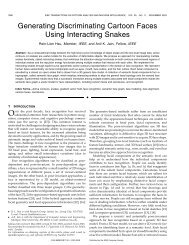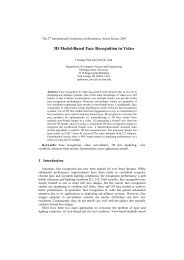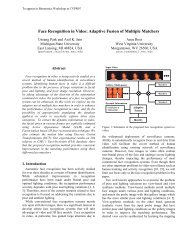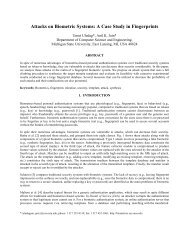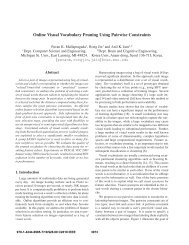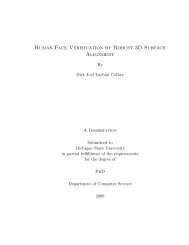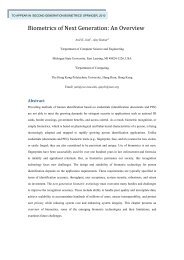Face Detection and Modeling for Recognition - Biometrics Research ...
Face Detection and Modeling for Recognition - Biometrics Research ...
Face Detection and Modeling for Recognition - Biometrics Research ...
Create successful ePaper yourself
Turn your PDF publications into a flip-book with our unique Google optimized e-Paper software.
shows the results of local refinement <strong>for</strong> the face boundary, the nose, the left eye, <strong>and</strong><br />
the mouth.<br />
Although our displacement propagation smoothes non-feature skin regions in the<br />
local adaptation, these skin regions can be further updated if a dense range map is<br />
available. However, based on our experiments, we find that the update of non-feature<br />
skin regions does not make a significant difference except in cheek regions because the<br />
displacement propagation already smoothes the skin regions surrounding each facial<br />
feature. Figure 4.10 shows the overlay of the final adapted face model in red <strong>and</strong><br />
the target facial measurements in blue. For a comparison with Fig. 4.4, Fig. 4.11<br />
(a)<br />
(b)<br />
Figure 4.10. The adapted model (in red) overlapping the target measurements (in<br />
blue), plotted (a) in 3D; (b) with colored facets at a profile view.<br />
shows the texture-mapped face model. The texture-mapped model is visually similar<br />
to the original face. We further use a face recognition algorithm [78] to demonstrate<br />
the use of 3D model. The training database contains (i) 504 images captured from<br />
28 subjects <strong>and</strong> (ii) 15 images of one subject generated from our 3D face model,<br />
108



